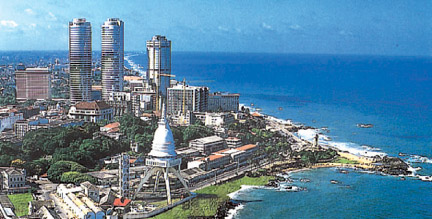|

by Sumana Saparamadu
Do you live in Colombo? Is your school in Colombo? If so, where in
Colombo? Colombo is a large sprawling city. Is it in Colombo 3, 4, 7 or
8? Or is it in Colombo 14 or 15?
What do these numbers indicate? They are the postal zones into which
the city of Colombo is divided. If your home or school is in Wellawatte
you are in zone 6 - Colombo 6. If it is in Kotahena then you live or
your school is in Colombo 13.
 Way back in 1947, the city of Colombo was divided into postal zones,
to make sorting and delivery of letters easy. The huge pile of letters,
postcards and parcels, with a Colombo address arriving at the General
Post Office (GPO) from the outstations, and those collected from the
numerous letter boxes in the city must first be sorted out into zones. Way back in 1947, the city of Colombo was divided into postal zones,
to make sorting and delivery of letters easy. The huge pile of letters,
postcards and parcels, with a Colombo address arriving at the General
Post Office (GPO) from the outstations, and those collected from the
numerous letter boxes in the city must first be sorted out into zones.
Now, letters with an address in Havelock Town, Thimbirigasyaya or
Kirillapone, are all put in the zone 5 - Colombo 5 heap. Later the
postmen in that zone will sort out the letters to be delivered in his
round. He may be the postman for Kirillapone or Narahenpita both in
Colombo 5.
Now, when you send a letter to a friend or relation in Colombo, write
the name of the road but you need not write the name of the suburb viz.
Bambalapitiya or Dematagoda. Giving the name of the road and the zone
number will do. The postman will sort out the letters addressed to his
own delivery area in that zone. A postal zone is a large area and there
are many postmen in each zone.
The City of Colombo is divided into wards too. Each ward is
represented in the Municipal Council by a ward member, elected every
four years. There are 47 wards and, therefore, 47 Municipal Councillors.
If there is a problem unattended to, in your ward, for a long time, you
should complain to the ward member, and he will or he should attend to
that problem and put it right. To do this you must know your ward, (the
ward you reside in) the name of the ward member and his private address
and contact telephone number.
Then again, the city is divided into electorates. Residents aged 18
and over, elect members to represent them in Parliament. The electorates
are Colombo North, Colombo Central, Colombo West, Colombo East and
Borella.A lighthouse stands just north of Galle Face Green and near the
port, shining its beams guiding seamen approaching the port of
Colombo.Colombo was the Capital of Sri Lanka from 1815 until Sri
Jayewardenepura was declared the capital from 1982.
Colombo Municipal Wards
1.Mattakkuliya, 2. Modera, 3. Mahawatta, 4. Lunupokuna, 5.
Bloemendhal, 6. Kotahena East, 7. Kotahena West, 8. Kochchikade N., 9.
Gintupitiya, 10. Aluthmawatha, 11. Masangasweediya, 12. New Bazaar, 13.
Grandpass N., 14. Grandpass S., 15. Maligawatta, 16. Aluthkade E., 17.
Aluthkade W., 18. Kehelwatta, 19. Kochchikade S., 20. Fort – Port, 21.
Kompannaweediya, 22. Wekanda, 23. Hunupitiya, 24. Suduwella, 25.
Panchikawatta, 26. Maradana, 27. Maligakanda, 28. Maligawatta E., 29.
Dematagoda, 30. Wanathamulla, 31. Kuppiyawatta E., 32. Kuppiyawatta W.,
33. Borella N., 34. Borella S., 35. Narahenpita, 36. Cinnamon Gardens,
37. Kollupitiya, 38. Bambalapitiya, 39. Milagiriya, 40. Thimbirigasyaya,
41.Havelock Town, 42. Wellawatte N., 43. Kirillapone, 44. Kirula, 45.
Pamankada E., 46. Pamankada W., 47. Wellawatta S.
Postal Zones - Colombo
Fort – 1, Slave Island – 2, Kollupitiya – 3, Bambalapitiya – 4,
Havelock Town and Kirillapone North – 5, Wellawatte, Pamankada and
Kirillopane South – 6, Cinnaman Gardens – 7, Borella – 8, Dematagoda –
9, Maradana and Panchikawatta – 10, Pettah – 11, Hulftsdorp – 12,
Kotahena and Kochchikade – 13, Grandpass – 14, Mutwal, Modera,
Mattakkuliya, Madampitiya – 15.
The Colombo Museum
The Colombo Museum as it was called at the beginning was established
on January 1, 1877. It founder was Sir William Henry Gregory the British
Governor of Ceylon (Sri Lanka) at the time.
 The Royal Asiatic Society (CB) was instrumental in bringing to the
notice of Gregory on his appointment as Governor in 1872 the need for a
public museum. With much difficulty the approval of the legislative
Council was obtained within a year. The Architect of the Public Works
Department, J. G. Smither was able to prepare the plans for the new
structure on Italian architectural style. The Royal Asiatic Society (CB) was instrumental in bringing to the
notice of Gregory on his appointment as Governor in 1872 the need for a
public museum. With much difficulty the approval of the legislative
Council was obtained within a year. The Architect of the Public Works
Department, J. G. Smither was able to prepare the plans for the new
structure on Italian architectural style.
Construction work was completed in 1876 and the Museum commenced it
functions the following year.
The construction of the Museum was carried out by Arasi Marikar
Wapchi Marikar Bass (born 1829, died 1925) who descended from the Sheiq
Fareed family that arrived in Ceylon in 1060 AD. He was the paternal
grandfather of Sir Razik Fareed, Kt., OBE, MP (born December 29, 1893,
died August 23, 1984).
Wapchi Marikar Bass was the builder of the General Post Office in
Colombo, Colombo Customs, Old Town Hall in Pettah, Galle Face Hotel,
Victoria Arcade, Finlay Moir building, the Clock Tower, Batternburg
Battery and many other buildings that are still standing today.
The Old Town Hall in Pettah, which is now a busy market, was built on
a contract for 689 Sterling Pounds. |



